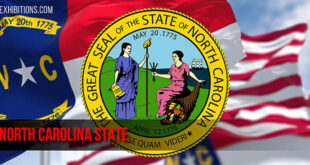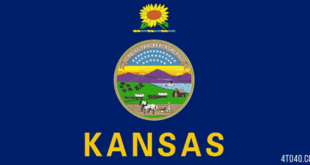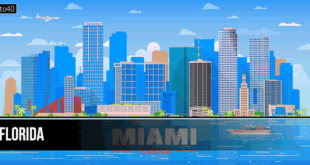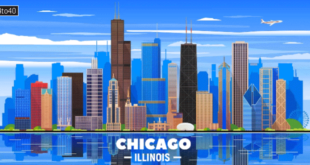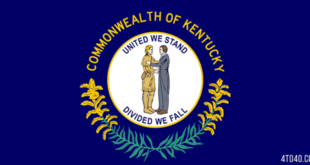New Jersey, a Middle Atlantic state located between New York on the north and east and Pennsylvania and Delaware on the west, occupies a peninsula bounded by the Delaware and Hudson rivers. The state’s northern border is its only artificial limit. The Atlantic Ocean to the southeast provides an attractive and popular resort area. The “waistline” of the state is the corridor between New York City and Philadelphia, which has proved to be both a blessing and a curse. New Jersey’s location has provided both impetus and market for agriculture, commerce, industry, and services, as well as cultural stimulation. Because of its location, however, New Jersey has suffered from a lack of identity, although that is changing now with growing awareness of the state’s key position in the Northeast Corridor, or megalopolis.
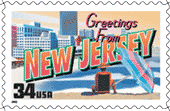
Only 47th in size among the states, New Jersey ranks 9th in population. It is the most densely populated state. New Jersey’s large population has brought on major problems of competitive land use, allocation and development of new energy sources, conflict among levels of government, water pollution, and the reduction of air quality.
Named for the island of Jersey, one of the Channel Islands, New Jersey was the 3rd of the 13 colonies to enter the Union. Its capital, Trenton, was the site of Washington’s first decisive victory of the American Revolution in 1776.
New Jersey State: Land & Resources
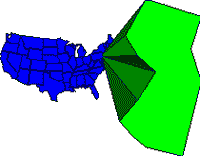 New Jersey exhibits landform diversity unusual in so small a state. It contains parts of the Atlantic Coastal Plain and the Appalachian Highlands, two major North American landforms. These can be further divided into five distinct sections, lying in parallel northeast-southwest bands.
New Jersey exhibits landform diversity unusual in so small a state. It contains parts of the Atlantic Coastal Plain and the Appalachian Highlands, two major North American landforms. These can be further divided into five distinct sections, lying in parallel northeast-southwest bands.
The Outer Coastal Plain along the Atlantic, occupying about 46% of the state’s area, is fringed with barrier islands, lagoons, and tidal marshes interrupted by estuarine rivers. The coastline undergoes constant modification by wave action, longshore currents, and human activity. The flat Pine Barrens cover about a third of the state inland from the coast.
The Inner Coastal Plain (about 13% of the state’s area) is a strip of land that averages 20 km (12 mi) in width and slopes toward the Delaware River and Delaware Bay. Toward the northeastern end of this section are the Navesink Highlands, the highest mainland point on the Atlantic Coast.
The three sections of the Appalachian Highlands are products of a complex geologic past that resulted in a pattern of ridges and lowlands. The northern portion, an area of glacial deposition, contains lakes, ancient lake beds, and rock-abraded surfaces.
The Piedmont section, containing 20% of the land area and 70% of the population, shows the effects of human habitation with spreading suburbs, filled wetlands, and dense road networks found alongside primitive swamplands and rugged geologic Watchung Mountains and the PALISADES. Dinosaur fossils have been found in Triassic deposits in several localities.
The Highlands (13% of the land) are characterized by narrow flat-topped ridges separated by small valleys containing lakes, such as Hopatcong, Mohawk, and Greenwood, that are used extensively for recreation. A large variety of unusual minerals in this area makes it popular among mineral collectors.
The Ridge and Valley section, occupying less than 10% of the land, is dominated by flat-topped Kittatinny Mountain. At its northern end is High Point and at the southwestern end is the spectacular DELAWARE WATER GAP. A fertile valley lies immediately to the east, part of a lowland that extends from Georgia to the Saint Lawrence River.
Climate
Its location in eastern North America, within the belt of prevailing westerly winds, has given New Jersey a climate characteristic of an inland location rather than that of a coastal area. The July average temperature range is 21 deg to 24 deg C (70 deg to 76 deg F), and the January range is -2 deg to 3 deg C (26 deg to 37 deg F). The growing season decreases from more than 255 days in the south to less than 100 in the northwest. The interaction of cold, dry air masses from the northwest with warm, moist air masses from the south produces varied weather patterns. Precipitation is evenly distributed through the year, with a slight maximum in late summer; amounts range from more than 1,270 mm (50 in) in the higher elevations to less than 1,020 mm (40 in) near the coast. Severe northeasterly storms in late winter and occasional hurricanes in the warm months cause considerable coastal damage.
Historical Sites
New Jersey has preserved many historical sites, particularly those of the Revolutionary War periods. Morristown National Historical Park encompasses the Ford Mansion, the Wick House, and Jockey Hollow. Battlefield monuments have been erected at Monmouth, Princeton, Trenton, and Red Bank. Other historic sites include the Edison National Historic Site in West Orange and Walt Whitman’s house in Camden.
Tourism
Tourism is a leading source of income in New Jersey. Within the state are portions of Gateway National Recreation Area, Delaware Water Gap National Recreation Area, Palisades Interstate Park, and four national wildlife refuges. The state-parks system maintains numerous parks, state forests, wildlife protection areas, and state marinas. The STATUE OF LIBERTY and ELLIS ISLAND are within the New Jersey waters of New York Bay. New Jersey’s shore resorts are famous. Casino gambling in Atlantic City has rejuvenated this once-decaying resort, known for its boardwalk and the Miss America Pageant. Old inland summer resorts, particularly around Lake Hopatcong and Budd Lake, have become year-round residences for many inhabitants. Winter sports, particularly skiing, are commercially important. The Meadowlands Sports Complex is the home of professional football, ice hockey, and basketball teams. It also contains a track for thoroughbred and harness racing.
New Jersey State: History
The earliest inhabitants of the New Jersey area are believed to have lived in the region as early as the 11th century BC. The inhabitants at the time of European arrival were Lenni Lenape, or DELAWARE, Indians–farmers, fishers, and hunters of the Algonquian language group. Three linguistic groups lived in the area: the Munsee, the Unami, and the Unalachtigo. By the time the Europeans arrived, the Indians had established permanent villages. The major threat to those inhabitants, other than disease, came from the Iroquois to the north.
The area was claimed by the English, French, and Dutch on the basis of explorations (1524-1623) by John Cabot, Henry Hudson, Giovanni da Verrazano, and Cornelius Mey. The Dutch established NEW NETHERLAND in what is now New York and New Jersey. The then-powerful Swedes established small settlements on the Delaware River; it is here that Swedish and Finnish settlers built what are thought to be the first log cabins in North America (see NEW SWEDEN).
Cultural differences in trade and land-ownership practices created conflict, and the earliest Dutch settlements in New Jersey were destroyed during Indian attacks. In 1660, under the direction of Gov. Peter Stuyvesant, the fortified village of Bergen–present-day Jersey City–became the first permanent New Jersey settlement.
In 1664, England began to press colonial claims, and the name New Jersey was first used in a deed that gave the area to John, Lord Berkeley, and Sir George Carteret. Except for a brief return to Dutch rule in 1673, New Jersey remained British until the American Revolution. In 1676 the colony was divided from northwest to southeast into West New Jersey (Berkeley’s portion) and East New Jersey (Carteret’s portion). The boundary line was subsequently redrawn twice. Present-day county boundaries and private property lines suggest the final demarcation. West New Jersey, purchased by a group led by William Penn, served as a haven for persecuted English Quakers. East New Jersey attracted many New Englanders. These people, along with Dutch, Swedes, Scots, Irish, Germans, and French Huguenots, gave New Jersey greater cultural diversity than any other area. This lack of homogeneity contributed heavily–along with the initial division of the colony–to New Jersey’s persistent lack of cohesiveness and identity. In 1702 the two proprietorships joined to form the royal colony of New Jersey.
During the colonial period industry began to grow in the Pine Barrens with the manufacture of iron and glass from local bog iron ores and sands. Iron was also produced in the northwest from local ores. Commerce was important, and New Jersey’s highways were the best in the colonies because of its location between New York and Philadelphia and between the northern and southern colonies. Most of the population practiced subsistence agriculture, but specialization in truck crops began early in the areas closest to New York and Philadelphia.
New Jersey’s strategic location and cultural diversity created many hardships during the American Revolution. Individual loyalties based on economy, religion, and cultural heritages resulted in a bitter local civil war within the larger conflict. Both British and colonial armies occupied, plundered, and marched repeatedly across the region. The major battles of TRENTON and MONMOUTH, along with many skirmishes, were fought in New Jersey. Washington’s army spent two harsh winters at MORRISTOWN, protected from the British by the Watchung ridges to the east. For four months in 1783, because of a mutinous disturbance in Philadelphia, PRINCETON was the capital of the new country.
During the War of 1812 the need for rapid overland transport through the state resulted in road improvements that later provided routeways for railroads. Following the war large numbers of European immigrants arrived, swelling the populations of the state’s cities. Although commerce remained the dominant economic sector until 1840, the state’s industries expanded with increased demand and a growing labor force.
The sentiment of New Jersey’s population was divided during the Civil War, with many people sympathetic to the Southern cause. The state did not support Abraham Lincoln in his reelection bid for the presidency in 1864, but cast its votes for George B. McClellan, a New Jersey Democrat.
During the 19th century, New Jersey gained attention as the location for significant inventions. John Stevens built the nation’s first steam locomotive and the world’s first steam ferry line in HOBOKEN during the early 1800s. Later in the century, Thomas Alva Edison set up his laboratory in New Jersey at Menlo Park and later at West Orange for work on the light bulb, phonograph, and motion pictures. The state’s research tradition has continued into the present day, with such developments as the telecommunications satellite in 1962 and the transistor in 1948.
Because of its intensive industrialization and high population density, New Jersey has enacted legislation to protect the environment–one of the first states to do so. Special emphasis is placed on maintaining air quality and protecting coastal and wetlands areas. Predictions for New Jersey’s future indicate continued growth, but at a somewhat slower pace. Its favorable location and skilled work force remain its finest assets for the years to come.
New Jersey State: Land
- Area: 22,590 sq km (8,722 sq mi); rank: 47th.
- Capital: Trenton (1990 census, 88,675).
- Largest city: Newark (1990 census, 275,221).
- Counties: 21.
- Elevations: highest–550 m (1,803 ft), at High Point; lowest–sea level, at Atlantic coast.
 Kids Portal For Parents India Kids Network
Kids Portal For Parents India Kids Network




